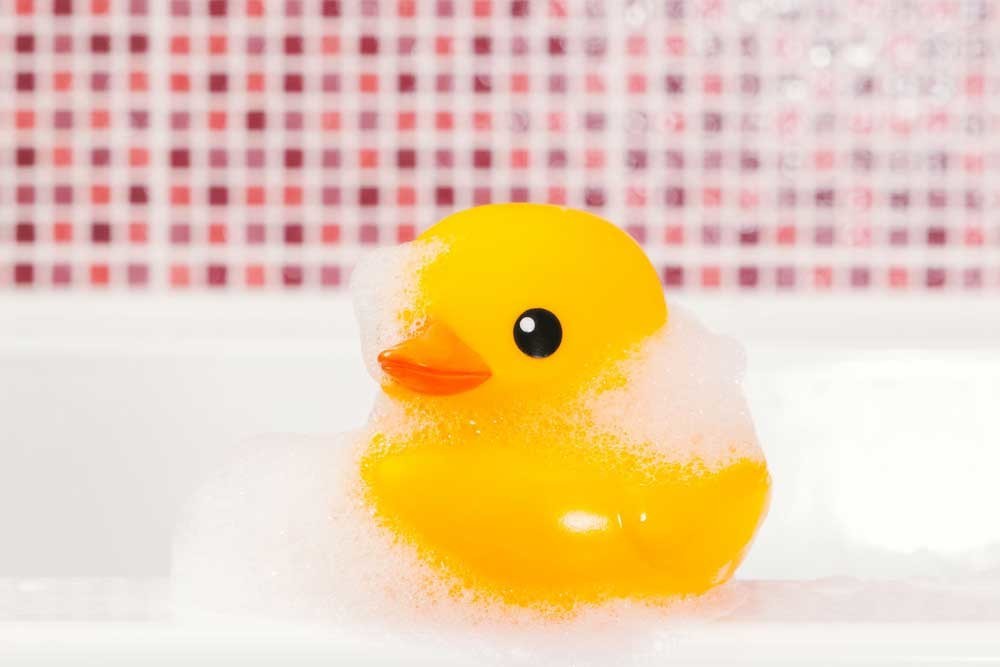Kids Bath Toy Storage
Giving your child a bath each evening is a great way to bond, improve hygiene, unwind, and have fun. Throw a few toys in the tub and laughter is practically guaranteed. After all, who doesn't giggle when squirted with water from a rubber ducky?

Not to burst your bubble (bath), but a recent study found that those beloved bath toys may be ickier than they appear. We're talking fungi galore. Discover what, exactly, lurks inside those cute, plastic sea creatures, how it might affect your little one's health, and what you can do to lower the germ count.
What's Happening Inside That Ducky
Researchers looked at 19 bath toys that were used in real-life, everyday conditions, as well as six identical bath toys that were used in controlled conditions (either clean water prior to bathing or dirty water after bathing). The findings weren't pretty: Fungi were identified in 58 percent of all real bath toys, and all of the real-life toys had bacteria on them, with 61 percent testing positive for a bacteria called Pseudomonas aeruginosa, which can cause ear infections, skin rashes, and other infections. Eek!
How come? It likely has to do with several factors. The tiny hole in the bottom of each toy is where the main problem lies. It easily lets in water, but it's harder for the water to get out (and be honest—how often do you remember to squeeze out all the toys after a bath?). When water and moisture build up inside the toy, germs can thrive. The flexible synthetic polymeric materials that most bath toys are made from—usually polyvinyl chloride (PVC) or silicone rubber—encourage microbial growth. Germs can also infiltrate these toys due to the tap water quality, stuff that gets in the water from body wash and shampoo, and stuff that comes from the bathers themselves (like dirt, sweat, and urine).
Of course, being exposed to some bacteria is not necessarily bad for human health. In fact, the study authors say, it may strengthen the immune system. However, they also note that children are particularly sensitive and vulnerable to disease, and squeezing icky water onto their faces or onto their bodies, for example, could potentially result in an eye, ear, wound, or gastrointestinal infection.
So What Can You Do?
To reduce the number of germs in the bathtub, try one of these simple solutions:
Fill the holes. Let the toys completely dry and then plug the holes using a hot glue gun.
Replace the toys. If your toys are old or you can see mold on them, toss them. When replacing them, seal the holes from the start, or buy bath toys that come sealed for a lower chance of bacterial or mold growth, like these ones from CaaOcho.
Clean the toys regularly. If you don't want to buy new toys, squeeze the water out of the ones that you already have and clean them at least once a week. Add ½ cup of white vinegar to a gallon of warm water, soak the toys for 10 minutes, then scrub. To clean their insides, suck up the solution, shake them around, then squeeze them out. Let toys completely dry.
Store the toys wisely. After the bath is over, where do you put the toys? Is it a spot that allows water to drain out of them? Consider buying a rack for the tub that has holes in it and put the toys away carefully with the hole-side on the bottom. Open a window or run the fan (like you do after a shower) to keep excess moisture out of your bathroom air.
Skip toys completely. Another option: Hand your child some plastic measuring cups for filling and dumping. Or entertain your kid without any toys at all—play children's music, sing songs and nursery rhymes, make up stories, practice counting and spelling, or splash around with your hands.
Get more great health and wellness stories at Parents.com/Strive .
Source: https://www.parents.com/featured/StriveBathToysNotFunIdea







